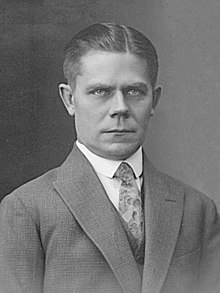Vares cabinet
The Vares Cabinet was the first communist government after the Soviet occupation of the Republic of Estonia . The puppet government loyal to Stalin was in office from June 22 to August 25, 1940.
Historical background
In the secret additional protocol to the German-Soviet nonaggression pact of August 23, 1939, Hitler and Stalin added the Republic of Estonia to the Soviet sphere of interest. The Red Army occupied Estonia on June 17, 1940 with around 90,000 soldiers. This was preceded by a Soviet ultimatum of June 16, 1940 and a sea and air blockade of the country.
The Estonian armed forces and authorities did not resist to avoid unnecessary bloodshed. The Commander-in-Chief of the Estonian Army, General Johan Laidoner , and the Soviet head of delegation Meretskow signed an agreement to this effect on June 17, 1940 in Narva during the ongoing occupation, the so-called Narva Diktat . The bourgeois Prime Minister Jüri Uluots and his government had already submitted their resignation on June 16, 1940 in protest against the Soviet ultimatum.
The world public took little notice of the occupation of the Baltic states, as Germany attacked France, the Netherlands, Belgium and Luxembourg at the same time.
Communist government
For the picture, the new Soviet ruler wanted a calm transfer of power at home and abroad. On June 21, 1940 at 6:00 p.m., Stalin's governor in Tallinn, Andrei Schdanow , presented the cabinet list to the Estonian President Konstantin Päts . It was made out by Päts and announced on Estonian radio at 10:15 p.m. The new government officially took office with the swearing-in by the President the following morning.
The government under the new Prime Minister, the left-wing writer Johannes Vares , comprised left-wing Estonian intellectuals and members of the labor movement. Leading communists of the previously banned Communist Party of Estonia (EKP) or Estonians of Russian descent were initially not among them. However, almost all members of the government already joined the Communist Party in July and August, which was re-admitted on July 4th.
The Vares government did not play a decisive role. The actual state power lay with Zhdanov and the Soviet legation in the country.
Immediately with the Soviet occupation of Estonia, the Stalinist persecution against dissenters began. On July 14 and 15, 1940, in a climate of fear and persecution of anti-communist opponents, sham elections to the Estonian Parliament ( Riigivolikogu ) took place. Non-communist candidates were excluded from the election.
On July 21, 1940, the newly elected parliament unanimously renamed the Republic of Estonia the Estonian Soviet Socialist Republic ( RT 1940, 74, 733). Two days later it asked unanimously for admission as a Union republic to the Soviet Union. This request was granted on August 6, 1940. As a next step, the Riigivolikogu deposed President Päts, who was deported with his family to the interior of Russia at the end of July .
Parliament set about drawing up a new Estonian constitution based on the Soviet model, which was adopted on August 25, 1940. It had been approved by the Central Committee of the CPSU three days earlier .
The Riigivolikogu renamed itself on August 25, 1940 in "Provisional Supreme Soviet of the Estonian Soviet Socialist Republic" ( Eesti NSV Ajutine Ülemnõukogu ). With the entry into force of the new constitution, the previous Vares government was replaced by the "Council of People's Commissars of the Estonian SSR" ( Eesti NSV Rahvakomissaride Nõukogu ).
Vares government
| Department | Surname | Term of office |
|---|---|---|
| Prime Minister | John Vares | July 22, 1940 to August 25, 1940 |
| Deputy Prime Minister | Hans Kruus | July 22, 1940 to August 25, 1940 |
| Foreign minister | Nigol Andresen | July 22, 1940 to August 25, 1940 |
| Minister of Agriculture | Aleksander Jõeäär | July 22, 1940 to August 25, 1940 |
| Interior minister | Maksim Unt | July 22, 1940 to August 25, 1940 |
| Minister of transport | Orest Kärm | July 22, 1940 to August 25, 1940 |
| Minister of Justice | Boris Sepp | July 22, 1940 to August 5, 1940 |
| Minister of Justice | Friedrich Niggol | August 5, 1940 to August 25, 1940 |
| Economics Minister | Juhan Nihtig | July 22, 1940 to August 25, 1940 |
| Minister of War | Tõnis Rotberg | July 22, 1940 to August 25, 1940 |
| Minister of Social Affairs | Neeme Ruus | July 22, 1940 to August 25, 1940 |
| Minister of Education | Johannes Semper | July 22, 1940 to August 25, 1940 |
literature
- Sulev Vahtre (Ed.): Eesti Ajalugu VI. Tartu 2005, pp. 168-172.
Web links
- Historical background (Estonian)
- Declaration by the Vares government of June 22, 1940 on the creation of close and friendly relations with the Soviet Union and the dissolution of parliament
- photo


